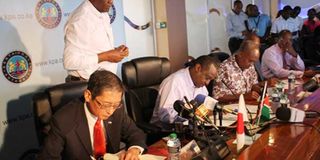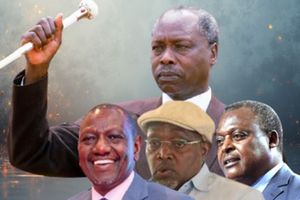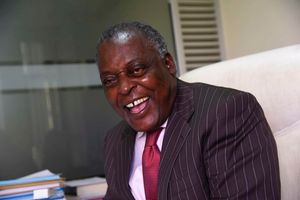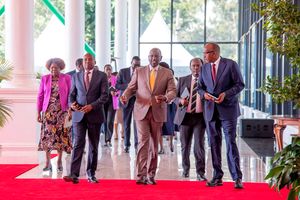Premium
Third bridge to link Mombasa Island and South Coast

From left: Japan's Ambassador to Kenya, Tatsushi Terada and the cabinet secretaries Henry Rotich (Finance) and Michael Kamau (Transport) sign a grant of Sh25 billion towards Mombasa port development project on January 16, 2015. Mr Terada said Japan would participate in the building of a third bridge to link Mombasa and the South Coast. PHOTO | LABAN WALLOGA | NATION MEDIA GROUP
What you need to know:
- Japanese Ambassador to Kenya Mr Tatsushi Terada mentioned this while addressing journalists in Mombasa.
- The ambassador said the two countries have been long time partners in development since Kenya’s independence.
- He urged the Kenyan government and the Kenya Ports Authority to apply Japanese technology in the implementation of phase II of the project.
- Mr Tatsushi insisted that the Japanese government was looking forward to long term cooperation with Kenya and Africa by transferring and sharing their technologies.
A third bridge linking Mombasa Island to the South Coast could soon become a reality with the Japanese government hinting that there were plans to construct a bridge across the Likoni ferry channel.
Japanese Ambassador to Kenya Mr Tatsushi Terada mentioned this while addressing journalists during the signing of a Sh25 billion deal between the Kenyan and Japanese governments for the construction of the second container terminal at the port of Mombasa.
“We will build the most beautiful bridge in the world with Japanese technology in Mombasa in the near future. The bridge will be named Likoni Bridge,” the ambassador said.
The ambassador said the two countries have been long time partners in development since Kenya’s independence.
“Japan has had a long history of cooperation with this port city of Mombasa. The Moi International Airport, the Nyali, Mtwapa, Kilifi and Sabaki bridges were the earlier fruits of our cooperation,” Mr Tatsushi said.
He urged the Kenyan government and the Kenya Ports Authority to apply Japanese technology in the implementation of phase II of the project.
LONG TERM COOPERATION
Mr Tatsushi insisted that the Japanese government was looking forward to long-term cooperation with Kenya and Africa by transferring and sharing their technologies.
He added that Japan’s wisdom and passion for development of Africa has been canvassed through the processes of the Tokyo International Conference on African Development (TICAD).
“We will continue to assist and share our experiences in order to support the nation building efforts of Kenya and Africa as a whole,” he said.
While receiving the loan, Finance Cabinet Secretary Henry Rotich said the signing marked another development of the close bilateral cooperation with the government and the people of Japan.
APPRECIATED JAPAN'S ASSISTANCE
“I wish to express, on behalf of the government of Kenya, our appreciation for the development assistance that we continue to receive from Japan since 1964.
“The infrastructure development support has been instrumental in accelerating the economic growth that we have achieved so far for the benefit of Kenyans,” Mr Rotich said.
He noted that Kenya has so far received financial support amounting to Sh443.5 billion from Japan.
Mr Rotich said the credit received will fund the development of the Mombasa Port expansion project. Specifically, the project will include the construction of the new container terminal Berth No. 22, procurement of equipment and consulting services.
“This is a high priority and critical project whose completion will enhance container handling capacity at the port,” the CS noted.
He added that the project will also complement the ongoing Mombasa port area road development project, and therefore contribute to higher economic development of the country.
Mr Rotich added that the Japanese government’s support will contribute directly to the country’s realisation of the Vision 2030.
“We have also received support to implement the Dongo Kundu bypass, which will ease movement and promote tourism in Mombasa,” he added.





